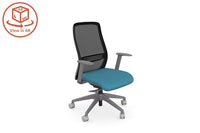Why use a Standing Desk:
In today's sedentary work culture, the popularity of standing desks has been steadily rising. And for good reason. These innovative workstations offer a multitude of benefits, not only for improving productivity but also for enhancing overall health and well-being.

When we spend prolonged hours sitting, it can lead to a host of health issues such as obesity, back pain, and even a higher risk of heart disease. Using a standing desk, on the other hand, encourages movement, which can help combat these issues.
But it's not just about physical health. Standing desks have also been shown to boost productivity. By allowing you to alternate between sitting and standing, these desks help keep your energy levels up and prevent the mid-afternoon slumps that often accompany long hours of sitting. Plus, being in an upright position can improve focus and concentration, leading to increased work efficiency.
Whether you're a professional looking to increase productivity or someone wanting to prioritise their health while working, investing in a standing desk can have a significant impact on your overall well-being. So why not give it a try?
The Benefits of Using a Standing Desk for Productivity
Standing desks have gained popularity in recent years, with many individuals recognising the dual benefits they offer in terms of health and productivity. One of the key advantages of using a standing desk is its positive impact on productivity levels. By allowing individuals to switch between sitting and standing positions, these desks help combat the lethargy and fatigue that often accompany prolonged sitting.

When you stand while working, you promote better blood circulation and oxygen flow throughout your body, which can help boost energy levels and cognitive function. This increased circulation can enhance focus and concentration, leading to improved productivity and performance. Standing while working also encourages subtle movements such as shifting weight or fidgeting, which can help prevent the stiffness and discomfort associated with prolonged sitting.
Furthermore, standing desks can help mitigate the dreaded mid-afternoon slump that many individuals experience after hours of sitting. By standing up and engaging different muscle groups, you can maintain a higher level of alertness and mental acuity throughout the day. This sustained energy and focus can result in higher work efficiency and output, making standing desks a valuable tool for enhancing productivity in the workplace.
How Standing Desks Can Improve Posture and Reduce Back Pain

One of the most significant benefits of using a standing desk is its positive impact on posture and back health. Prolonged sitting can cause slouching and poor posture, leading to muscle imbalances and spinal misalignment. Over time, this can result in chronic back pain and discomfort. By incorporating a standing desk into your workspace, you can reduce the strain on your spine and improve your overall posture.
Standing while working encourages a more upright position, which helps align the spine correctly and engage core muscles for support. This improved posture can alleviate pressure on the lower back and reduce the risk of developing musculoskeletal issues. Additionally, standing desks promote natural movement and changes in position, preventing the stiffness and tension that often accompany prolonged sitting.
For individuals who experience back pain or discomfort from sitting for long hours, transitioning to a standing desk can provide relief and prevent further strain on the spine. The dynamic nature of standing while working helps promote better spinal alignment and posture, reducing the likelihood of developing chronic back problems associated with sedentary behavior.
The Impact of Standing Desks on Cardiovascular Health
Cardiovascular health is a crucial aspect of overall well-being, and the use of standing desks can have a positive impact on heart health. Prolonged sitting has been linked to an increased risk of cardiovascular issues such as heart disease and stroke. The sedentary nature of sitting can lead to poor blood circulation, elevated blood pressure, and higher levels of cholesterol, all of which are risk factors for cardiovascular disease.
Standing desks offer a simple yet effective solution to combat these risks by promoting movement and increasing energy expenditure throughout the day. When you stand while working, your heart has to work slightly harder to circulate blood, which can help improve cardiovascular function over time. Studies have shown that incorporating standing breaks into your work routine can lower blood pressure, reduce cholesterol levels, and decrease the risk of developing heart-related conditions.
There are 7 main types of Standing Desks
- Corner (curved) Standing Desks
- L Shaped Corner Desks
- Double (Back to Back) Standing Desks
- K Shaped Ergonomic Standing Desks
- Scallop Standing Desk
- Standard rectangular Standing Desks
Furthermore, standing desks can help prevent the negative effects of prolonged sitting on arterial function and blood flow. By encouraging individuals to stand and move regularly, these desks support better cardiovascular health by maintaining optimal blood circulation and reducing the strain on the heart. Making small changes like using a standing desk can have a significant impact on reducing the risk of cardiovascular issues and promoting heart health.
Standing Desks and Weight Management
In addition to improving cardiovascular health and productivity, standing desks can also play a role in weight management and promoting a healthy metabolism. Prolonged sitting has been associated with weight gain and obesity due to the reduced calorie expenditure and metabolic slowdown that occur when inactive for long periods. Standing while working can help counteract these effects by increasing energy expenditure and promoting better metabolic function.
When you stand instead of sit, you engage more muscles and burn more calories throughout the day. This can have a positive impact on weight management and help prevent the accumulation of excess body fat. Additionally, standing desks encourage subtle movements and postural changes that can further boost calorie burning and support a more active lifestyle.
Furthermore, standing desks can help individuals maintain better blood sugar levels and insulin sensitivity, both of which are crucial for weight management and overall health. By incorporating periods of standing into your work routine, you can support a healthier metabolism and reduce the risk of developing weight-related conditions such as diabetes and metabolic syndrome. Standing desks offer a practical and effective way to promote weight management and support overall well-being.
Tips for Transitioning to a Standing Desk
Transitioning to a standing desk can be a positive step towards improving your health and productivity, but it's essential to approach the change thoughtfully and gradually. To make the transition smoother, consider the following tips:
- Start Slow: Begin by incorporating short periods of standing into your workday and gradually increase the duration over time. This gradual approach can help prevent fatigue and discomfort as your body adjusts to standing more frequently.
- Invest in Comfort: Choose a standing desk that is ergonomically designed and adjustable to suit your height and working preferences. Ensure that your monitor, keyboard, and mouse are positioned at comfortable heights to prevent strain on your neck and wrists.
- Wear Supportive Footwear: Opt for comfortable and supportive footwear that can help reduce the impact on your joints and muscles while standing. Consider using an anti-fatigue mat to provide cushioning and support for your feet.
- Take Breaks: Remember to take regular breaks to sit, stretch, and move around throughout the day. Incorporating short walks or gentle exercises can help prevent stiffness and promote circulation.
- Listen to Your Body: Pay attention to how your body responds to standing and make adjustments as needed. If you experience discomfort or fatigue, consider alternating between sitting and standing to find a balance that works for you.
By following these tips and listening to your body's cues, you can successfully transition to a standing desk and reap the many benefits it offers for your health and well-being.
Choosing the Right Standing Desk for Your Needs
When selecting a standing desk, it's essential to consider your specific requirements and preferences to find the right fit for your workspace. Here are some factors to keep in mind when choosing a standing desk:
- Adjustable Height: Look for a standing desk that offers adjustable height settings to accommodate different users and working positions. This flexibility allows you to customise the desk to your comfort level and ergonomic needs. View Our Standing Desk Range
- Workspace Size: Consider the dimensions of your workspace and the available area for the standing desk. Choose a desk that fits comfortably in your workspace and provides enough surface area for your work essentials.
- Stability and Durability: Opt for a standing desk that is stable and sturdy to support your work equipment and maintain safety while standing. Look for desks made from high-quality materials that can withstand daily use.
- Additional Features: Explore standing desks with additional features such as cable management systems, storage options, and ergonomic accessories to enhance your work experience and organisation.
- Budget: Determine your budget range and explore standing desk options that offer the best value for your investment. Consider factors such as warranty, customer reviews, and after-sales support when making your decision.
By considering these factors and conducting thorough research, you can select a standing desk that meets your needs and enhances your workspace for improved health and productivity.
Incorporating Movement and Ergonomics into Your Standing Desk Setup
To maximise the benefits of using a standing desk, it's essential to incorporate movement and ergonomics into your workspace setup. By following these guidelines, you can create a comfortable and productive environment while standing:
- Alternate Positions: Avoid prolonged standing or sitting by alternating between the two positions throughout the day. Listen to your body's cues and switch positions regularly to prevent stiffness and discomfort.
- Maintain Proper Posture: Stand with your feet hip-width apart, shoulders relaxed, and spine in a neutral position. Adjust the height of your desk and monitor to ensure that your neck and back are in alignment while working.
- Stretch Regularly: Incorporate stretching exercises and gentle movements into your work routine to prevent muscle fatigue and promote blood circulation. Focus on areas that tend to tense up while standing, such as the calves, hips, and shoulders.
- Stay Hydrated: Drink an adequate amount of water throughout the day to stay hydrated and maintain energy levels while standing. Dehydration can lead to fatigue and discomfort, so remember to hydrate regularly.
- Use Ergonomic Accessories: Consider investing in ergonomic accessories such as an adjustable chair, footrest, or monitor stand to enhance comfort and support while standing. These accessories can help reduce strain on your body and improve overall workspace ergonomics.
By incorporating movement, proper posture, and ergonomic principles into your standing desk setup, you can create a workspace that supports your health, productivity, and overall well-being.
Embracing a Healthier Work Lifestyle with Standing Desks
In conclusion, the benefits of using a standing desk extend far beyond improving productivity—they encompass enhanced health, posture, and overall well-being. By understanding the health risks associated with prolonged sitting and the positive impact of standing on cardiovascular health, weight management, and productivity, individuals can make informed decisions to prioritise their well-being while working.
Transitioning to a standing desk may require adjustments and patience, but the long-term benefits are well worth the effort. By incorporating movement, proper ergonomics, and listening to your body's needs, you can create a workspace that promotes health, productivity, and a healthier work lifestyle.
Investing in a standing desk is not just a trend—it's a proactive step towards improving your health and well-being in a sedentary work culture. By taking control of your workspace and incorporating standing breaks into your routine, you can experience the transformative effects of a more active and health-conscious approach to work. So why wait? Make the switch to a standing desk today and embrace a healthier work lifestyle for a better tomorrow.









0 comments